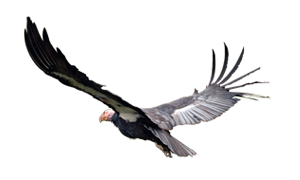Condor Comeback
by Sy Montgomery (Author), Tianne Strombeck (Photographer)
(Scientists in the Field Series)
HMH Books for Young Readers (July 28, 2020), 0544816536
Chapter 1: AT THE ZOO
She needs to do nothing more than to stand still to attract a crowd.
Perched on her favorite rock outcropping in the spacious exhibit the Santa Barbara Zoo, her wings clad in shiny, black feathers that rustle like taffeta, California Condor 174 is a giant among birds. She towers four feet tall (more than the average seven-year-old girl) and weighs nearly thirty pounds (as much as 100 baseballs). Her kind is the largest species of land bird in all of North America. Even her feathers are giants: Some of them grow two feet long. No wonder a group of people—including youngsters smaller than she—has gathered to watch her.
She turns her orange neck and head to face the onlookers. Her red, knowing eyes briefly meet ours. It feels like a meeting of minds. With her stooped posture and bald, wrinkled, jowly head, she looks like a wizened sorceress, a sage, a powerful, wise, old woman. When she raises her wings, holding them slightly open, she looks like she’s about to give a blessing— or cast a spell.
Then, the magic really happens: She hops twice, flaps thrice, and spreads her wings nearly ten feet wide to sail across her enormous pen.
“Wow! Look how big those wings are!” says a little girl wearing a pink sweatshirt and American flag sneakers.
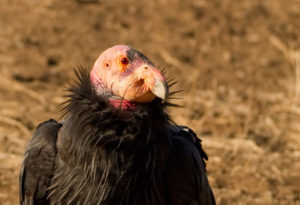
“Spread your wings!” a bearded dad urges his youngest daughter. Immediately, the little girl and her three siblings rush to compare their arm span to a life-size sign opposite the pen showing a condor’s yawning wingspan.
Thanks to these astonishing wings, a California condor can not only fly fifty-five miles an hour, but also soar to 15,000 feet. Even more impressive, a condor can glide for miles without flapping, riding on rising hot air called thermals and steering with just the tail and the tips of the long flight feathers. Condors don’t just traverse heaven; they dwell there.
It’s easy to see why these birds have thrilled and fascinated people for thousands of years. Once California condors could be found in western skies from Canada to Mexico, and some lived as far east as Florida. Native people revered them. To many tribes, the condor was sacred. This was with good reason: Flying so high, the condor sees all. And these birds may live for 60 or more years—long enough to grow wise.
But the California condor was not sacred to Western settlers. Far from it. The newcomers shot the birds for sport. Ranchers accused them—falsely—of killing livestock. By the time conservationists realized condors were disappearing, their slide into extinction seemed unavoidable.
“Aren’t they endangered?” a ponytailed woman watching 174 wonders.
“They are critically endangered!” answers Dr. Estelle Sandhaus. In fact, Estelle tells the visitor, they were once only twenty three of them left alive on the planet—and when the last one of them was captured in Southern California in April 1987, the California Condor was officially extinct in the wild.
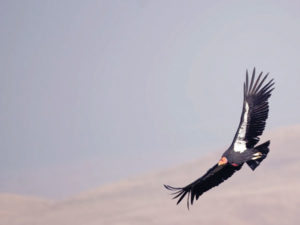
A 5’1″ firecracker of a woman, with shining brown hair, dancing brown eyes, and a laugh as exuberant as a waterfall, 41-year-old Estelle is the Santa Barbara Zoo’s Director of Conservation Science. A big part of her job is to help make sure California condors forever grace North American skies.
And that’s Condor 174’s job, too. Born March 4, 1998 at the San Diego Zoo Safari Park, 174 came to Santa Barbara on October 15, 2012, where she is now serving as a mentor to younger birds. “She’s the most dominant bird,” Estelle explains. “She’s got sass. She’s got attitude. She knows she’s the boss.”
At the moment, 174’s mentee is young Condor 603. She’s the youngest of the four California condors at the zoo (two others are not on display). Number 603 was born in the wild, but suffered a wing injury and was brought to the zoo. She can fly, but not well. At age three, she’s still a child by condor standards. She’s got much to learn—including condor manners. “They’re going to get rabbits today,” announces zoo bird keeper Ellie Culip. The condors eat four times a week. (In the wild, they sometimes eat so much they can’t fly for several hours, and might not eat at all for several days afterwards.) On today’s menu are white rabbits obtained from a breeder, who were humanely killed, frozen, and thawed.
Ellie walks inside a concrete tunnel built into the artificial rock outcropping in the exhibit. She dons plastic gloves and reaches into a white plastic bucket for the first of the two rabbits. There are two narrow tunnels built into the rock, each just a little longer than Ellie’s arm. Ellie will use one of these tunnels to push the food through to the condors on the other side.
Why not just hand the birds the carcass? “We never let them see us with the food,” says Ellie. If wild condors are fed by humans, they’ll search out people—and that can be dangerous for an entire flock, because they learn from watching each other. And though these condors aren’t slated for release—both will probably stay at a zoo for breeding or mentoring other condors—”we don’t want to limit their possibilities for the future if management changes,” Ellie says.
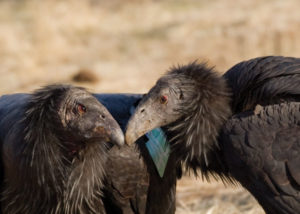
But it’s difficult to fool a condor. An orange face appears at the end of one of the tunnels. It’s 174. “They’re smart birds,” she explains. “They know I’m feeding them. But at least they never see me putting food down!”
As soon as it appears at the other end of the tunnel, 174 instantly grabs the rabbit with her beak. Then Ellie pushes the second rabbit through. This one is for the young 603, but, says Ellie, “I would not be surprised if 174 kicks off 603 and wants her rabbit, too!”
This is exactly what happens. 174 yanks the second carcass away. She isn’t being a bully. She’s being a good mentor. While condor parents lovingly feed their babies, when the chicks get older, they must learn the rules. And one of the most important rules is that after they leave the nest, youngsters must defer to their elders.
When condor conservationists first started raising captive-bred condors, the adolescents who were released to the wild were in for a rude awakening. They probably expected to be babied like they were in the zoo. “The hand-raised youngsters weren’t tough enough,” Estelle explained. “There was no condor culture to teach them respect. They didn’t know what to do or quite how to behave like a wild condor.”
A wild condor will behave toward a youngster just like 174 does towards 603: raising those formidable wings and showing off her sharp beak, the elder chases her young student away from the carcass again and again. But soon enough, when 174 has had her fill, there will be tasty scraps of flesh for 603 to enjoy left behind on the artificial rock outcropping. There’s plenty for both condors.
When Ellie exits the concrete bunker, in an adjacent pen, Veronica the turkey vulture hops over to see if the keeper might have a scrap for her. “Is this a baby condor?” one of the bystanders asks. “No,” answers Ellie. “But people ask that a lot. And it’s a smart question. Condors are vultures, after all.”
And that’s part of the uphill battle still being fought to save condors. “Vultures have a stigma,” says Estelle. “Some kids are like, ‘Ew, vultures! They’re mean. They’re gross. They eat dead things.'” Stories and films often portray vultures as icky. (Though at least Disney’s vultures are cool characters. In the original script for the first Jungle Book movie—the one that came out in 1967—the plan was for the four vultures to be voiced by The Beatles! When The Fab Four declined, the scriptwriter changed the singing vultures into a barbershop quartet.)
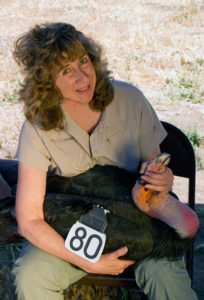
Estelle and Ellie tell kids that condors, like all vultures, are scavengers. “They’re not mean,” says Estelle. “They don’t even kill! ” (Indeed, the author of one magazine article insisted that the condor is “nature’s original conscientious objector”—a huge and powerful bird who “could be killer, but chooses instead to live in peace with his fellow creatures.”)
And condors are characters. Some are bold. Some are shy. Some are bossy. Some are brave. When Estelle first met 327, she held the bird during her health check. The next time 327 saw her, the feisty female remembered Estelle as the person who restrained her—and hissed at her in defiance!
“I love to tell kids how each one has a personality,” says Estelle. “They’re amazed that a bird can be as cool as a fox or an elephant. But it’s true.
“It makes me sad when I hear people say condors are ugly. They need to open their eyes to beauty that’s a little bit different,” Estelle urges. “I think they’re absolutely beautiful!”
Most visitors who spend time with condors agree. One zoo visitor comes regularly and sets up his easel in front of the condor exhibit to paint them.
Four-year-old Abigail Rose Drennan is just as ardent a fan as he. With her mom, Traci, and often with her brother, eight-year-old James, Abigail has visited the condor pen at the zoo once a week since the day she was born. “They are so big,” she says, hopping with excitement, “and I like them!”
Even though she’s only four, Abigail knows that the zoo is helping condors. “People have to help animals,” she says. “People should care because if condors are gone, it would be sad.”
But there was a time, not long ago, that many people, including some genuine conservationists, believed that condors should never be in a zoo. “The beauty of the California condor lies entirely in its matchless, soaring flight,” wrote one of the first researchers to study these birds, Carl Koford.
When he wrote these words, wild condors were already disappearing. But he objected to the idea of capturing them so they could breed in the safety of a zoo. “The California condor in a cage is ugly, pitiful and uninspiring,” he claimed. Friends of the Earth founder David Brower thought captive breeding was worse than extinction. Better, he thought, that they should “die with dignity” in the wild.
The naysayers have been proved wrong. Zoos have been key to the condor comeback. “The challenges condors are facing are entirely human in origin,” Estelle says, “and the good news is that the answers are also in human hands. We can do it. We know what to do. And this connects the people with the condors, so our visitors can be part of the solution.”
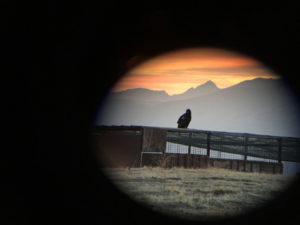
The solution is at once simple and complicated. If humans would just stop putting two foreign, toxic substances into the environment, the vast majority of premature condor deaths would be averted. But until people change their ways, folks like Estelle, and many others you’ll meet in this book, are working hard to give the magnificent birds a second chance at survival.
The effort to return California condors to the wild—a wild where they can safely live, breed, and raise their young without human help—is one of the most creative, controversial and concentrated wildlife restoration efforts in conservation history.
Today, the world’s population of California condors has grown from twenty-two to more than 450. A little over a third of them are in zoos like this one, where they are recuperating from illness or injury, teaching younger birds condor culture and etiquette, or mating, laying or incubating eggs to augment the still-small population of their kind.
Most of the world’s California condors fly free today—not just here in southern California, but in central California, Arizona, Utah, and Mexico. But even after half a century of human help, still the wild condors need constant monitoring. People still need to step in to help. Every California condor wears a wing tag with a number and telemetry so they can be located and followed. Every one still needs a regular health check—and sometimes medical treatment—in a battle for survival in a world polluted with human garbage and toxic metal.
“People say, ‘Fifty years and they’re not saved yet?!'” Estelle understands the frustration. At the zoo, Estelle’s also working on saving endangered Channel Island foxes. (With three subspecies of the foxes taken off the endangered species list, it’s the fastest successful recovery of a federally-listed endangered species in American history!)
Why is that project moving forward so much more swiftly than the condor recovery? “Foxes have litters every year. Condors aren’t old enough to find a mate till they’re six, seven or older. These are long-lived animals. This is like the marathon of conservation—while foxes are like the mile run.
“We’ve hit a lot of major milestones in the program to conserve condors,” she notes. “But we’re not done yet!”
This book tells the story of the California condors’ continuing comeback. Its history contains more plot twists than a mystery novel; the recovery program faced, faltered, and overcome a minefield of obstacles. But there are still more to go. This is the story of partnerships between birds and people, cooperation between zoos, other nonprofits, and state, federal and even international governmental organizations. It’s a story in roughly equal parts about human vision and human blindness. Even when you finish this book, you won’t know how the story ends— but you will know some of what it takes to save a species, and what you can do to help.
